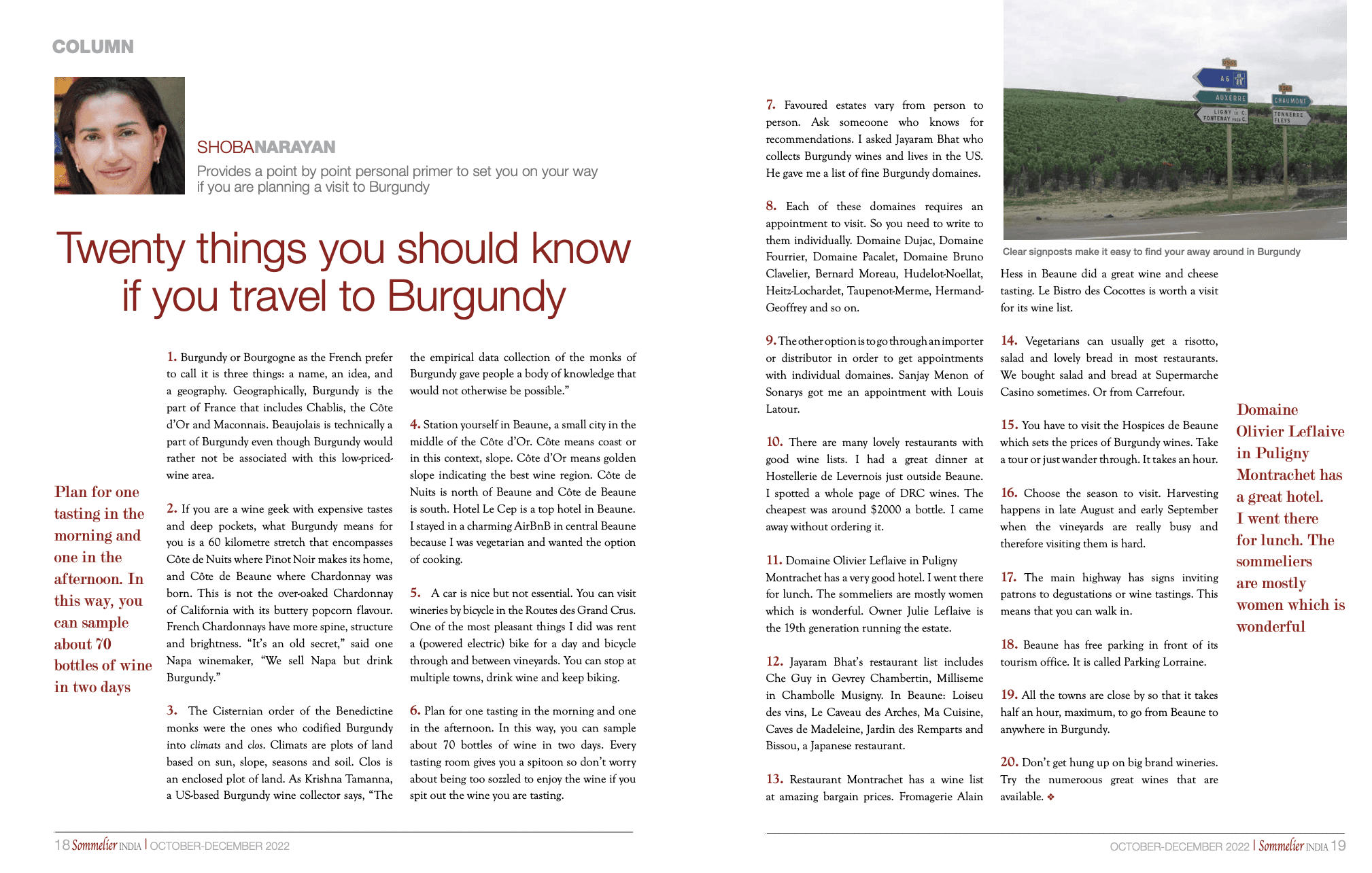Twenty things you should know if you travel to Burgundy

- Burgundy or Bourgogne as the French prefer to call it is three things: a name, an idea, and a geography. Geographically, Burgundy is the part of France that includes Chablis, the Cote d’Or and Maconnais. Beaujolais is technically a part of Burgundy even though Burgundy would rather not be associated with this low-priced-wine area.
- If you are a wine geek with expensive tastes and deep pockets, what Burgundy means for you is a 60 kilometre stretch that encompasses Cote de Nuits where pinot noir makes its home, and Cote de Beaune where Chardonnay was born. In between are the various appellations or parcels that every Burgundy lover knows almost by heart. The wines carry the names of the towns that they are grown in: Vosne-Romanee, Morey St. Denis, Chambolle-Musigny, Mersault, Aloxe-Corton and so on. At the centre is the town of Beaune. Drive North or upwards and you are in pinot noir country. Drive South and you are in Chardonnay country. This is not the over-oaked chardonnay of California with its buttery popcorn flavour. French chardonnays have more spine, structure and brightness. “It’s an old secret,” said one Napa winemaker, who, with good reason, asked not to be named. “We sell Napa but drink Burgundy.”
- The Cisternian order of the Benedictine monks were the ones who codified Burgundy into climats and clos. Climats are plots of land based on sun, slope, seasons and soil. Clos is an enclosed plot of land. As Krishna Tamanna, a US-based Burgundy wine collector says, “The amount of work, the rigid methodologies, and the empirical data collection of the monks of Burgundy gave people a body of knowledge that would not otherwise be possible. No other region has that body of knowledge.”
- Station yourself in Beaune, a small city in the middle of the Cote d’Or. Cote means coast or in this context, slope. Cote d’Or means golden slope indicating the best wine region. Cote de Nuits is North of Beaune and Cote de Beaune is South. Hotel Le Cep is a top hotel in Beaune.
- I stayed in an Airbnb because I was vegetarian and wanted the option of cooking. I found one in central Beaune which was charming.
- A car is nice but not essential. You can do wine-tasting via bicycle in the Routes des Grand Crus.
- One of the most pleasant things I did was rent a (powered electric) bike for a day and bicycle through and between vineyards. You can stop at multiple towns, drink wine and keep biking.
- Plan for one tasting in the morning and one in the afternoon. Go to one of the nice restaurants dotting the area in the evening. In this way, you can sample about 70 bottles of wine in two days. Every tasting room gives you a spitoon or spit bucket so don’t worry about being too sozzled to enjoy the wine. Of course you should spit out the wine you are tasting, especially if you are driving.
- A list of favoured domaines or estates varies from person to person. I asked Jayaram Bhat who collects Burgundy wines and lives in the US. He gave me a list of fine Burgundy domaines: Domaine Dujac, Domaine Fourrier, Domaine Pacalet, Domaine Bruno Clavelier, Bernard Moreau, Hudelot-Noellat, Heitz-Lochardet, Taupenot-Merme, Hermand-Geoffrey and so on. Each of these domaines requires an appointment to visit. So you need to write to them individually.
- The other option is to go through an importer or distributor in order to get appointments with individual domaines. Sanjay Menon of Sonarys got me an appointment with Louis Latour.
- There are many lovely restaurants with great wine lists. I had a great dinner at Hostellerie de Levernois just outside Beaune. I spotted a whole page of DRC wines. The cheapest was around $2000 a bottle. I came away without ordering it.
- Bhat’s list includes Che Guy in Gevrey Chambertin, Milliseme in Chambolle Musigny. In Beaune: Loiseu des vins, La Caveau des Arches, Ma Cuisine, Caves de Madeline, Jardin des Remparts, and Bissou, a Japanese restaurant with a great wine list. Restaurant Montrachet in Puligny Montrachet has an amazing wine list at bargain prices.
- Domaine Olivier Leflaive in Puligny Montrachet has a great hotel and restaurant. I went there for lunch and had a tasting of their wines. The sommeliers are mostly women which is great. Owner Julie Leflaive is the 19th generation of Leflaives running the estate.
- Fromagerie Alain Hess in Beaune did a great wine and cheese tasting. Le Bistro des Coccottes also has a good wine list.
- You have to visit the Hospices de Beaune which sets the prices of Burgundy wines. Take a tour or just wander through. It takes an hour.
- Choose the season to visit. Harvesting happens in late August and early September when the vineyards are really busy and therefore visiting them is hard.
- Vegetarians can usually get a risotto, salad and lovely bread in most restaurants. We bought salad and bread at Supermarche Casino sometimes. Or from Carrefour.
- The main highway has signs inviting patrons to degustations or wine tastings. This means that you can walk in.
- Beaune has free parking in front of its tourism office. It is called Parking Lorraine. All the towns are close by so that it takes half hour at maximum to go from Beaune to anywhere in Burgundy.
- Don’t get hung up on name brand wineries. Try a variety of wines that are available there.




Leave A Comment